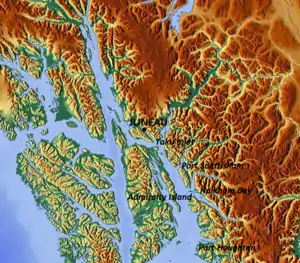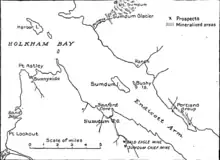Holkham Bay
Holkham Bay (also known as Sumdum Bay)[3] is a bay in the U.S. state of Alaska. It connects Tracy Arm and Endicott Arm on its east to Stephens Passage on its west.
| Holkham Bay | |
|---|---|
| Sumdum Bay | |
 Holkham Bay and nearby mountains in the Chuck River Wilderness. | |
 | |
| Coordinates | 57.7458333°N 133.6252778°W |
| Type | Bay |
| Native name | Sum Dum (Tlingit) |
| Etymology | Holkham, England |
| Ocean/sea sources | Inside Passage |
| Basin countries | United States |
| Max. width | 6 miles (9.7 km) |
| Max. depth | 217 feet (66 m) |
| Islands | Harbor Island |
| References | [1][2] |
Etymology
Holkham Bay was named for Holkham, a community in Norfolk, England by George Vancouver. The Tlingit knew the bay as Sum Dum, reportedly referring to the sound of ice falling off glaciers into the water.[4] This led to the alternate name of Sumdum Bay in use today. Some mines in the area borrow both names.[1]
History

The land surrounding Holkham Bay was inhabited by Tlingit people, along with much of the rest of Southeast Alaska.[5] European discovery and its modern name came in 1794 after Joseph Whidbey, exploring as part of the Vancouver Expedition, reported the bay upon his return to George Vancouver.[1] Whidbey reported several hostile encounters with the Tlingit on his journey.[6]
Holkham Bay served as one of the operational bases for Canadians working to define the Canada–United States border to resolve the Alaska boundary dispute in the late 19th Century.[7]
Mining
Gold was mined from quartz veins found in the black graphite slate. The Sumdum Mine is located 2.5 miles (4.0 km) south of Sanford Cove. Two ledges constitute the Sumdum Chief and Bald Eagle Mines and "have been mined to a depth of several hundred feet below their surface outcrops." Supporting structures included a 10-stamp mill, four large Frue Vanners, two Pelton wheels, a wagon road, a short tramway, and a wharf.[8]
Gold was mined by the Portland Group from a silicious schist ore body containing gold-bearing pyrite, galena, and sphalerite.[8]
Geography
Holkham Bay sits about 45 miles (72 km) south of Juneau, Alaska on the east side of Stephens Passage across from the Class Peninsula of Admiralty Island. Tracy Arm extends to the north from the bay to Sawyer Glacier. Endicott Arm leads southeast from the bay to Dawes Glacier.[1] Both arms are fjords, which formerly held glaciers along their entire lengths. The bay is separated from the adjacent arms by an area of shallower water.
Harbor Island is the largest island in the bay, with the Round Islets making up the other islands.[2] The island and the land surrounding the bay are part of the Tongass National Forest with some areas being part of the Chuck River Wilderness (to the south) and the Tracy Arm-Fords Terror Wilderness (to the east).[1]
References
- U.S. Geological Survey Geographic Names Information System: Holkham Bay, USGS GNIS.
- "Bathymetric Data Viewer". U.S. National Oceanographic and Atmospheric Administration. Retrieved October 2, 2022.
- United States. Census Office (1893). Report on the Population and Resources of Alaska at the 11th Census, 1890 (Public domain ed.). U.S. Government Printing Office. pp. 47–. Retrieved 6 February 2013.
- "Sumdum Mine, Sanford Cove | CoastView". Retrieved 2 October 2022.
- de Laguna, Fredericæ. "Tlingit." Suttles, Wayne, ed. Handbook of North American Indians, Vol. 7: Northwest Coast. Washington, D.C.: Smithsonian Institution, 1990: 203–28. ISBN 0-87474-187-4.
- Vancouver, George (1798). A Voyage of Discovery to the North Pacific Ocean, and Round the World. Vol. 1. London: G.G. & J. Robinson, and J. Edwards. p. 35.
- "The Alaska Boundary Survey". Seattle Post-Intelliger. 7 May 1893. p. 4. Retrieved 2 October 2022.
- Arthur C. Spencer (1906). The Juneau Gold Belt, Alaska, USGS Bulletin No. 287. United States Government Printing Office. pp. 43–45.